The Role of Aoudad in Restoration of High-Desert Mountain Wildlife and Habitat
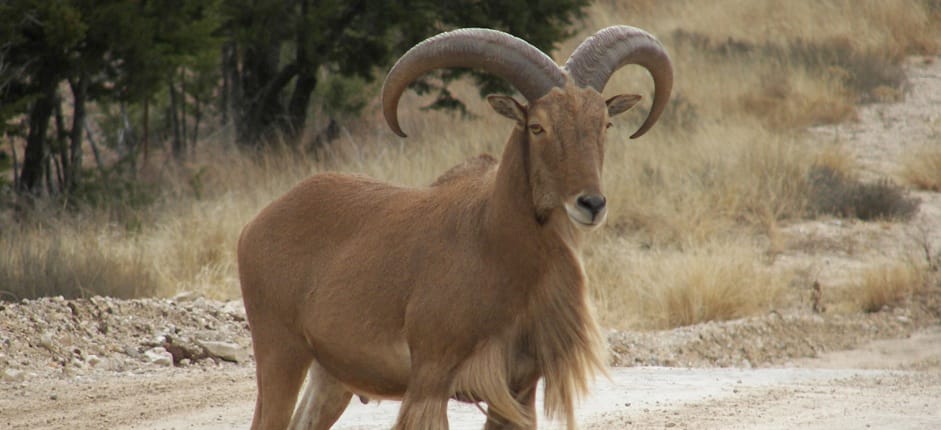
At Circle Ranch we understand that biodiversity is good, not bad, and act accordingly. In that context, here is common sense on aoudad.
The Ammotragus Advantage
…by Brandt Buchanan
To begin, I would like to declare that the following theories have not been proven by any specific study pertaining to aoudad (Ammotragus lervia). On the other hand, the anti-aoudad theories accepted as fact by the universities, agencies and “conservation” organizations are also without scientific proof.
The following is a series of potential contributions to our ecosystem by introduced free-ranging aoudad.
Not so long ago I thought it would be hard to make any claim that, aoudad serve a positive role in our ecosystem with the exception of economic benefits. In retrospect, I realize that this notion was a product of the preconditioned stigma that competitive consumption of resources is the only factor that holds weight when analyzing the relationship between similar species. This oversimplification suggests that each and every species lives and survives independent from all other species that do not overlap resource consumption in an ecosystem. The problem with this is that, a species is not a drain, the roles a species play in an ecosystem is much more complex than input and output. This would be like saying a farming operation is inefficient because it has too much equipment which cannot possibly be maintained because the revenue of a farm enterprise is controlled by a fixed income. Instead I would like to propose the various ways a tool in the form of aoudad may play in maximizing the utility of a specific niche and increasing the productivity of an ecosystem.
Revenue for the community
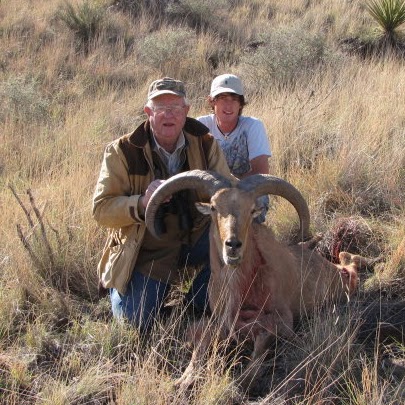
The ever increasing popularity of aoudad hunting deemed the “blue-collar bighorn” has provided many hunters the opportunity to participate in a true sheep hunt, which was previously only available to hunters willing to spend $12,000- $150,000 for such an experience. A romantic and enlightening experience, revered as most empowering experience within the culture of hunting.
This expanding enterprise has created hundreds of jobs within our community. An aoudad hunt cost $5,000 on average, with an estimated $1,000 per hunter spent in our community. Each aoudad hunt employs two to four people for its duration. Considering hundreds of these hunts are conducted annually, this could add up to millions of dollars of revenue for our community. (www.surveymonkey.com Aoudad economic impact survey 2014). It has provided much needed supplemental income for landowners even preventing some historic family ranches from being sold and divided due to increasing taxes, cost of maintenance and difficulties with profitability within the livestock industry. In addition, these hunters also spend money within our community and increase hunting license sales.
Toxic and unpalatable vegetation usage
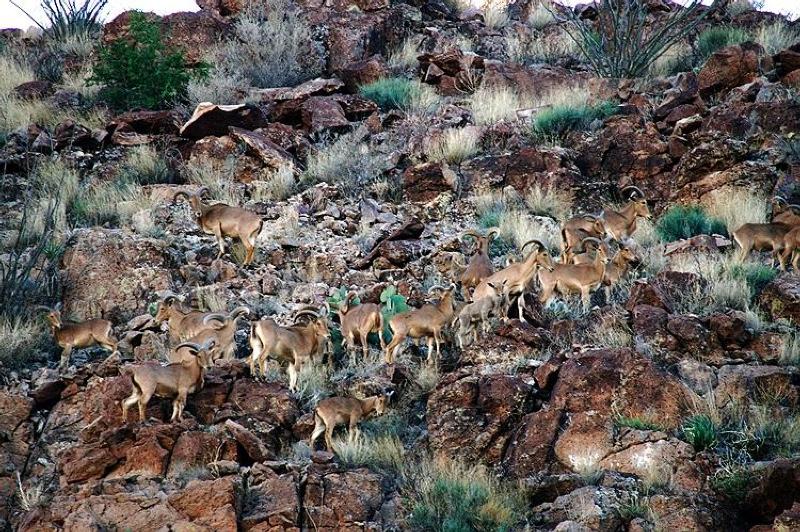
Aoudad have been observed consuming toxic plants such as Silver leaf nightshade and Golden corydalis. (G.G. Gray, C. David Simpson 1980). Aoudad are able to digest nearly every form of vegetation in the Trans-Pecos. “Native” species are much more selective consumers, which is a reason listed as why aoudad are perceived to have the ability to “outcompete” such species.
Considering the aoudad’s nomadic nature, when feeding on bunch grasses they seem to graze quickly over large areas, removing the woody or dried portions and exposing and facilitating the increase of nitrogen-rich new growth preferred by many species in the Trans-Pecos. It has also been noted that many grasses must decay biologically before the next growing season in order for continued annual growth. Through trampling and transformation by digestion, aoudad can help to facilitate the production of grasses.
While “native” species are able to utilize various succulent such as yuccas, aoudad are better suited to expose the moisture and nutrient rich hearts. Due to their constant movement, they leave much of the unharvested portions of these plants more easily accessible to other wildlife. After a yucca is harvested it then dries, falls over and is washed or kicked to the nearest arroyo which creates small dams catching and slowing the movement of water and valuable organic material
Contour terracing of degraded slopes
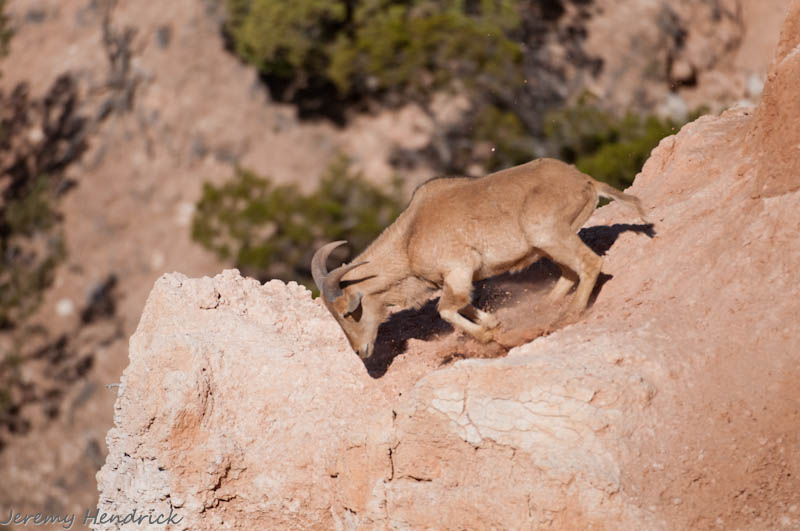
This summer we’ve been blessed with ample rainfall and at times seemingly torrential downpours. I always hated to see all that precious moisture fall and then just wash away along the path of least resistance where much will be lost to evaporation as it travelled down the slopes into solid rock drainages. If only there was a way to keep that moisture in the mountains and encourage even distribution throughout the landscape.
In the diverse soils and structures of the Sierra Viejas, I noticed something occurring naturally that was accomplishing just that. On the side of some of the most barren slopes, standing back a few hundred yards, I noticed what appeared to be countless contoured terraces every 20 feet or so in elevation rise. Upon closer inspection I discovered the “terraces” were game trails covered in feces, aoudad feces. Stricken by drought and plagued by a poor limestone-based soil, little vegetation existed before the summer. The aoudad seem to favor this hill I suspect because of the amount of small loose aggregate, which signals any movement – big or small — on the hillside. After the rain, native grasses began to grow and every day the slope grew greener and greener, beginning at and spreading below these game trails.
This alteration of the terrain by aoudad traffic appeared to slow the movement of water down the hill and increase water retention and distribution, not only from the contoured terraces but also by the amount of dry organic material dropped and caught by these terraces. Further this precious organic material had been compacted by aoudad foot traffic and urine; thereby, reducing wind erosion and serving as a sponge for the rainfall in the monsoon season.
Studies have proven the value of contour terracing in preventing erosion and promoting vegetation growth.
Nutrient and organic material elevation and retention
In the last section, I discussed aoudad activity impacting water retention by slowing its flow downward, but now I would like to propose a theory of organic material elevation. Theoretically it’s impossible for matter to oppose gravity and we know rainfall, which contributes to carrying this matter downward, is subject to gravity just the same as any other form of matter. So if the ball always rolls downhill how is there life at the top of any mountain? The answer is simple: a force stronger than gravity must be present to overcome the perpetual trend of organic matter moving closer to the center of the earth (lower elevations).
In the Trans-Pecos, we have a force more than willing to do the job….aoudad. Aoudad prefer high elevations and rough terrain; however, they do venture down to feed, breed and water. If an aoudad feeds at 3,500 feet and beds at 5,000 feet that evening and defecates, it has just carried organic material back up the mountain. Through this perpetual movement throughout the elevations, they serve as an elevator for the material needed by other life forms to survive and in massive quantities. This would suggest that the niche fulfilled by aoudad is crucial to the constant replenishment of nutrients to underutilized terrains and elevations.
Microorganisms are present in all soils in varying amounts. When organic residue from plants and animals is provided, their numbers rise spectacularly. These tiny organisms are largely responsible for the decomposition of organic material. (http://imnh.isu.edu/digitalatlas/geo/soils/soiltxt/soilmn.htm) If organic material is does not decay biologically, it’s forced to decay via oxidation which takes much more time and reduces the nutrient content of such material.
Soil erosion by water is commonly recognized as the one of main reasons of land degradation worldwide (e.g. Ananda & Herath, 2003; Beskow et al., 2009; Valentin et al., 2005). Soil erosion rates, caused by water, are highest in agrisystems located in hilly or mountainous regions. Among soil characteristics several properties influencing erodibility may be determined: aggregate stability, organic matter and clay particles content. Various types of soil erosion may be triggered by rainfall, thaw and runoff water: sheet, rill, and gully erosion (Askoy & Kavvas, 2005; Grønsten & Lundekvam, 2006; Valentin et al., 2005).
According to literature reports, these effects of soil erosion may be divided into several main groups: changes in mechanical and mineral compositions of soil, changes and transformations of ground surface morphology, amendments in water balance of eroded catchments and reduction of soils’ fertility (e.g. Fullen et al., 1998; Lado & Ben-Hur, 2004; Pimentel & Kounang, 1998; Valentin et al., 2005; Widomski et al., 2010; Widomski & Sobczuk, 2007). The reported changes in mechanical and mineral compositions of soils are reflected by decreased content of organic matter and alerted content of all soil fractions (i.e. removal of clay fraction and increase of coarse ones), which in turn may be reflected in decreased water permeability and water capacity of eroded slope and increased volume of generated surface runoff. (Terracing as a Measure of Soil Erosion Control and Its Effect on Improvement of Infiltration in Eroded Environment, Marcin K. Widomski, Lublin University of Technology, Poland, 2011)
This method of altering steep terrain has been implemented for thousands of years by humans and is now being done for free by the aoudad in these regions. It is hard to beat free help.
Conclusion
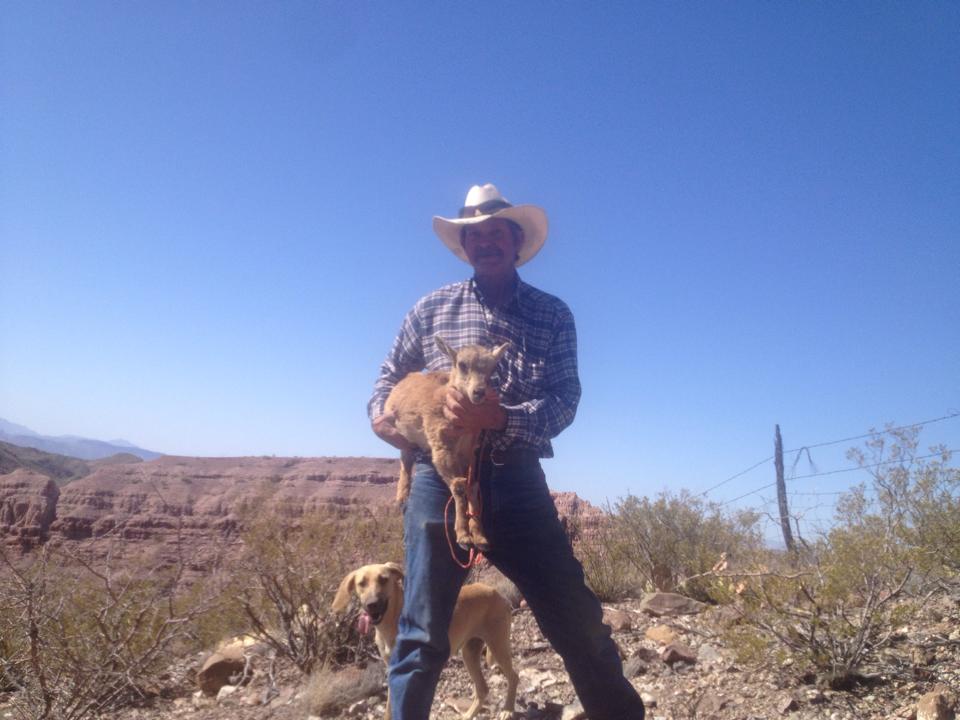
Although aoudad have been vilified as thieves of forage, water and habitat, I want you to consider the holistic effects of this species not only relative to the regional economy, but also as a contributor to the ecosystem’s health. Just like any other organization, as it grows its demand for a diverse team does as well. An ecosystem is like a very complex machine, if you remove one part and try to operate the machine before you replace the part, it will not function properly and may cause irreparable damage.
“We should preserve every scrap of biodiversity as priceless while we learn to use it and come to understand what it means to humanity.”– E. O. Wilson
“If we pollute the air, water and soil that keep us alive and well, and destroy the biodiversity that allows natural systems to function, no amount of money will save us.”-David Suzuki
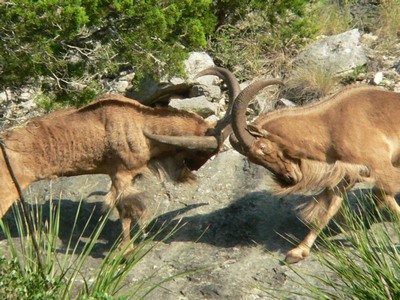
Editor’s Comment:
Aoudad are beautiful animals which fill an empty niche in our far-West Texas ecosystems, and thereby help all wildlife and habitat.
We cannot restore our desert mountain habitats and wildlife unless we increase their biodiversity and we cannot save that biodiversity by destroying biodiversity: Sadly, while biodiversity is universally praised in principle, its preservation is increasingly ignored in practice.
To read more about Big Wildlife’s war on aoudad and many other wild animals and plants, click here.
